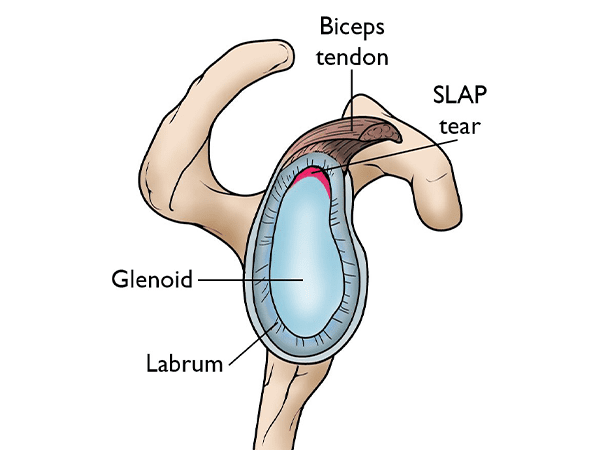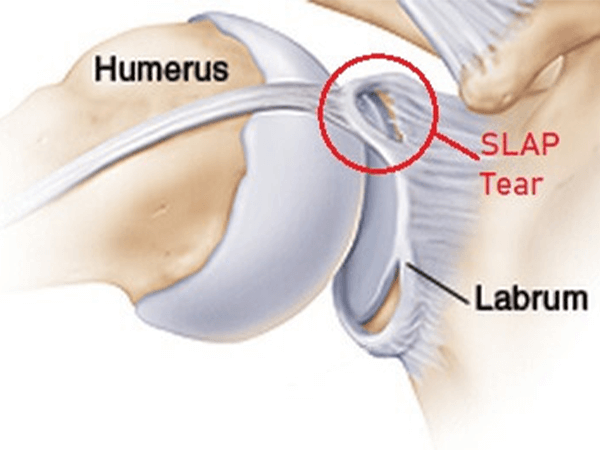What are SLAP Tears?
SLAP tears, or superior labarum anterior and posterior tears, are injuries to the labarum, which is a ring of cartilage that surrounds the shoulder joint. The labarum helps to keep the humerus (upper arm bone) in the glenoid fossa (socket of the shoulder joint).
SLAP tears can occur in a variety of ways, including
Overuse: SLAP tears are common in athletes who participate in overhead sports, such as baseball, volleyball, and tennis. These sports involve repetitive overhead motions that can stress the labarum.
Trauma: SLAP tears can also occur from a sudden, forceful impact to the shoulder, such as a fall or a direct blow.
Age: SLAP tears can also occur because of aging. The labarum can become weaker and more susceptible to tears over time.
Symptoms of a SLAP tear may include:
Pain: The most common symptom of a SLAP tear is pain in the front of the shoulder. The pain may be worse with overhead activities, such as throwing or reaching overhead.
Weakness: SLAP tears can also cause weakness in the shoulder, making it difficult to lift the arm overhead or to reach behind the back.
Crepitus: Crepitus is a grating or popping sensation that may be felt with movement of the shoulder.
Locking: The shoulder may feel as if it locks or catches during movement.
What are the Symptoms of SLAP tears?
The symptoms of a SLAP tear can vary depending on the severity of the tear. Some common symptoms include.
Pain in the shoulder, especially with overhead activities
A popping or clicking sensation in the shoulder.
Weakness in the shoulder
Reduced range of motion in the shoulder
A feeling of instability in the shoulder
If you are experiencing any of these symptoms, it is important to see a doctor to get a diagnosis and treatment.

SLAP tears are most common in athletes who participate in overhead sports, such as baseball, volleyball, and tennis.
SLAP tears can be diagnosed with a physical exam, imaging tests, and a shoulder arthroscopy.
Treatment for SLAP tears depends on the severity of the tear. Mild tears may be treated with physical therapy and pain medication. More severe tears may require surgery.
The goal of treatment is to relieve pain, improve range of motion, and restore strength to the shoulder.
With proper diagnosis and treatment, most people with SLAP tears can return to their normal activities.
What Causes SLAP TEARS?
SLAP tears can be caused by a variety of factors, including:
Acute trauma: This can include a fall onto an outstretched arm, a direct blow to the shoulder, or a sudden forceful movement of the arm.
Repetitive overhead motion: This is the most common cause of SLAP tears. Athletes who participate in overhead sports, such as baseball, softball, volleyball, and swimming, are at increased risk for SLAP tears.
Age: SLAP tears are more common in people over the age of 40. This is because the labarum can wear down over time, making it more susceptible to tears.
Degenerative arthritis: This condition can cause the labarum to become weak and frayed, increasing the risk of tears.
Inflammation: This can weaken the labarum and make it more likely to tear.
How is a SLAP tear Diagnosed?
The goal of surgery for a SLAP tear is to repair the labarum and restore stability to the shoulder joint. Surgery can be done arthroscopically, which means that small incisions are made in the shoulder and a camera is inserted to guide the surgeon. In some cases, surgery may need to be done through a larger incision.
After surgery, you will need to wear a sling or immobilizer for several weeks. You will also need physical therapy to regain range of motion and strength.
The recovery time for a SLAP tear can vary depending on the severity of the tear and the type of surgery that was performed. Most people can return to their normal activities within 6-12 months.

How do You Treat Shoulder Osteoarthritis?
Surgical treatments: If non-surgical treatments are not effective, surgery may be an option. Surgical treatments for shoulder osteoarthritis include:
Arthroscopy: Arthroscopy is a minimally invasive surgery that allows the surgeon to view the inside of the shoulder joint. This surgery may be used to remove damaged cartilage or bone, or to repair the rotator cuff.
Total shoulder replacement: Total shoulder replacement is a surgery that replaces the damaged shoulder joint with an artificial joint. This surgery is typically reserved for people who have severe pain and limited function that is not relieved by other treatments.
The best treatment for shoulder osteoarthritis will vary depending on the severity of the condition and the patient’s individual needs. If you are experiencing pain or stiffness in your shoulder, it is important to see a doctor to discuss your options.
Here are some additional tips for managing shoulder osteoarthritis.
Avoid activities that put stress on your shoulder. This may include activities such as overhead lifting, swinging a bat or racquet, or swimming.
Use proper lifting techniques. When lifting, keep your shoulder close to your body and use your legs to do most of the work.
Strengthen your shoulder muscles. Strengthening your shoulder muscles can help to improve stability and reduce pain. You can do this with exercises such as shoulder shrugs, rows, and presses.
Stretch your shoulder muscles. Stretching your shoulder muscles can help to improve range of motion and reduce stiffness. You can do this with exercises such as arm circles, shoulder rolls, and front raises.
Get enough rest. Getting enough rest can help your body to heal and reduce pain.
